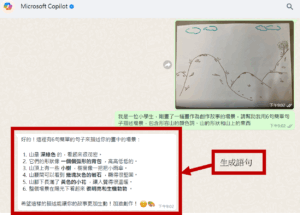
透過人工智能生成圖像技術 擴闊學生詞彙量
文/陳鈺蓮
記得當年從事前線語文教師工作,為擴闊學生認字量,教學過程會加入學生的「心理詞彙」作為認讀材料。例如想學生多學習食品的名稱,便會展示一些超級市場食品貨架的圖片作為輔助,希望學生透過圖片觀察,口述出他們熟悉的食品名稱,老師便從旁捉緊每個學生口述的字音提供字形,課堂中老師忙於充當一部「人肉寫字機」。
隨着人工智能的發展,不禁便想:讓AI代替老師擔任「人肉寫字機」吧。以下將展示利用人工智能「圖像轉換文字」及「生成圖像技術」,協助教師幫助難以運用「語音輸入」和提取詞彙能力偏弱的學生擴闊詞彙量。
教學對象:高小 (讀寫能力大約處於一、二階水平)
教學目標:
範疇 | 預期成果 |
閱讀 | 能理解閱讀材料的內容NLR(2.1)2 |
能欣賞作品中詞句的運用LR(3.2~LR4.2)5 | |
能欣賞作品中生動活潑的描寫LR(3.2~LR4.2)6 | |
說話 | 能運用略有變化的詞語表情達意NLS2.4 |
表情達意用語恰當,詞匯較豐富NLS4.4 | |
寫作 | 能表指示修改作品中表達欠清楚的文句NLW(3.4)2 |
教學材料:《西遊記‧美猴王》(改寫:管家琪,幼獅文化,台灣,2003)
AI平台:Copilot (WhatsApp)、Poe Assistant
教學流程:
一、 導入:展示文中有場景描寫的語段
很久很久以前,大海中有一座山,叫作花果山,山上有四季長青的草本,和終年不斷、各式各樣的水果。 (管家琪,2003) |
二、 閱讀策略──心像
- 請學生在紙上根據語段繪出「山」的形象和周圍的景物。
我們的想像

- 學生完成繪圖後,老師請學生以小組形式提取詞彙,並填寫下表:
文字的描述 (可用中文或英文詞彙表達)
形狀 Shape | 顏色 Colour | 山上 有 / 沒有 的東西 Things |
1. | 1. | 1. 有 |
2. | 2. | 2. 有 |
3. | 3. | 3. 沒有 |
4. | 4. | 4. 沒有 |
三、 「W」(Write):
- 運用AI「圖像轉換文字」技術,生成與圖畫相關的詞彙
- 把學生作品拍照並上傳至Copliot
- 以下列Prompt生成相關描述語句
Prompt
我是一位小學生,
剛畫了一幅畫作為創作故事的場景,
請幫助我用6句簡單句子描述場景,
包含形容山的顏色詞、山的形狀和山上的東西

四、 「I」(investigate)及「S」(Synthesize):補充「心理詞彙」
- 補充「心理詞彙」
- 學生閱讀生成語句,選擇並補充原有詞彙
- 重看故事文章,進一步補充或修正詞彙
- 選擇適用的詞彙撰寫成語句,作為生成圖像的Prompt
五、 生成圖像
- 利用Poe Assisstant平台,輸入下列Prompt
Prompt
我是一位小學生,你是一位繪圖專家。
請根據下列描述,為我生成一幅場景。
場景描述如下「這山叫作花果山,山是深綠色的,看起來很茂密。山的形狀像一個個弧形的背包 ,高高低低的。山上有長青的草木,樹葉像一把把小雨傘。山上有各式各樣的水果、有鹿、有猴子。」

六、 「E」(Evaluate):
展示用不同修訂及補充的Prompt而生成的圖像,以比較描述及生成圖像的關連,從而突出文字描述如何有效構建畫面。

今次的教學設計主要分享當有了AI生成式技術後,教師的角色不再單單協助學生提取字形,寶貴的課時亦不只是抄寫「心理詞彙」。透過AI生成式技術,教師可以針對生成的內容帶領學生進行選擇、補充,進一步推高預期成果。在認讀更多相關的詞彙後,教師訓練學生從中選擇適用的詞彙作為描述句子,並讓學生親身體驗如何運用人工智能協助個人表達。











 已複製鏈結
已複製鏈結